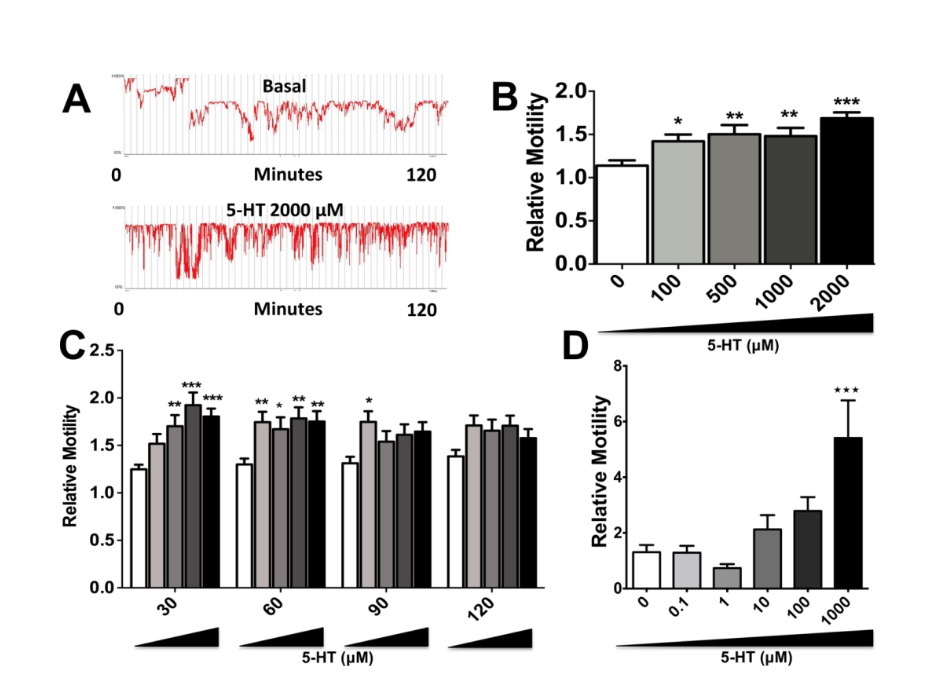
Cestode parasites are flatworms with the ability to parasitize almost every vertebrate species. Several of these parasites are etiological agents of neglected diseases prioritized by WHO. The parasitic flatworms Echinococcus granulosus sensu lato (s. l.) and Mesocestoides corti are tapeworms belonging to the class Cestoda, with E. granulosus s. l. belonging to Taeniidae and M. corti to Mesocestoididae family.
Materials And Methods:
The Echinococcus species are important parasites of wildlife, domestic animals and people worldwide.
This parasite is a well-established model for laboratory studies and the tetrathyridium is used to examine drug effects on neuromuscular activity. Previously, we have shown that 5-HT induces E. granulosus protoscolex motility [See Ref. The nervous and prenervous roles of serotonin in Echinococcus spp. (Camicia F., 2013)]. In spite of some evidence about 5-HT action on M. corti motility [3], the kinetics of this important neurotransmitter n motility over longer periods of time (>30 minutes) was unknown. In this work, we analyzed the effect of 5-HT on motility of the tetrathyridia of M. corti.
Results:
To study the effect of 5-HT on the motility of M. corti tetrathyridia, only one worm per well was used as this was the empirically determined optimal number. Addition of more tetrathyridia to each well plate did not result in a better signal. M. corti tetrathyridia were used fresh, immediately after the mice was opened. One tetrathyridium per well in 100 μl of RPMI with high glucose (Gibco) was pipetted to U-shape 96-well microplates and incubated overnight at 37 ̊C in a 5% CO2 atmosphere. The following day, basal activity recordings were performed for 2 h at 37 ̊C in the worm tracker. After the initial 2 h, 25 μl of the same medium containing 5-HT at the indicated concentrations were added and the motility of parasites was recorded in the resultant 125 μl of medium for another 2 hours. Twenty-five microliters of fresh medium alone were added to the controls before registering motility in the resultant 125 μl. In order to avoid any potential difference between individuals not related to the effect of the 5-HT, the activity found in each well was divided by the activity found in the same well in the basal record. Each experiment was performed using 16 technical replicates per treatment condition. In order to count with biological replicates, four independent experiments, with tetrathyridia coming from different mice were performed.
The addition of serotonin to tetrathyridia resulted in the stimulation of the motility above basal levels (S6 Fig.). The channel activity traces show a stimulation in frequency of movement at high doses of 5-HT compared to the basal condition (S6A Fig). The dose-response curve showed a significant rise of motility starting from 100 μM of 5-HT (p< 0.05) until the highest concentration tested of 2000 μM over a period of two hours ( p< 0.001; S6B Fig). Dose-response curves were also collected over different intervals of time (30, 60, 90 and 120 minutes). These graphs showed that the shape of the curve changes with time (S6C Fig). At the highest concentrations tested (500 to 2000 μM), the relative motility tends to drop with time after the first 30 minutes of incubation, losing their significance respect to control, probably reflecting an inactivation process. At the lowest dose (100 μM) the motility tends to rise during the first 90 minutes of incubation and then also it tends to fall after 120 minutes of incubation (S6C Fig). Similar concentrations of 5-HT (1000 μM; p< 0.001) are necessary to see significant changes in motility over a period of 30 minutes by video imaging (S6D Fig).

…………………………………………………………………………………………………………………………..
PLoS Negl Trop Dis. 2018 Feb 9;12(2):e0006267. doi: 10.1371/journal.pntd.0006267. eCollection 2018 Feb.
Camicia F, Celentano AM, Johns ME, Chan JD, Maldonado L, Vaca H, Di Siervi N, Kamentezky L, Gamo AM, Ortega-Gutierrez S, Martin-Fontecha M, Davio C, Marchant JS, Rosenzvit MC.
